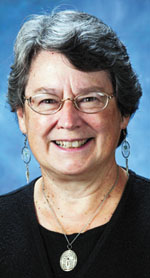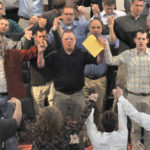By Corinne Winter
My husband and I recently watched a Christmas movie in which popular artist Thomas Kincaid told of a mentor who advised him to “Paint the light.” Kincaid interpreted the advice to mean that he should find and point out through his work the light of God’s glory as it is manifest in the world around us. Whatever one’s feelings about Kincaid’s work, it seems to me that the call to see and point out the light of Christ present within our world challenges all of us during the Christmas season as we contemplate the doctrine of the Incarnation. We see and hear so much about the darkness, the evil that is found in our world, that we may be tempted to cynicism. But the story of Christmas is the story of the Divine Son taking on humanity, coming into the world, claiming the world as God’s creation and God’s possession not finally to be swallowed up by evil.

As I read and listen to the messages of the prophets during Advent, I find in them a marvelous balance. On some days we seem to hear mostly condemnations of what Israel is doing wrong. On other days, we are admonished not to give up, to remember the faithfulness of God and to persevere in hope no matter how bad things may look. There is light beyond the darkness and the darkness will not prevail.
Ultimately, the message of the Incarnation is that the world created by God belongs to God and is destined for God’s Reign. Thus the world and all its peoples by nature not only can but yearn to welcome God, to be filled with divine life, the light that can and will crowd out the darkness. That doesn’t make us blind or immune to the real existence and power of evil. The Gospel of John says that the light shines in the darkness and the darkness will not overcome it. But it does not say that the darkness goes away entirely. Christ in his preaching did condemn sin where he saw it, but he also called even the worst of sinners to repentance and new life.
The message of the Incarnation challenges us not only to be hopeful ourselves, but to bring hope to others. As Christians, we are called to be light to the world and not to hide our light. How can we be light? In at least two ways: shed the light of truth against falsehood, against injustice against ambitions that are unsuited for the dignity of the human person created by and for God. And point out the light that we see in others. Sometimes my mother calls me after seeing a whole program of horrible news and talks about feeling really discouraged. I tell her that at those times, I look at and think about the people closest to me, about family, friends and church. It is there that I see the goodness remaining in this world, that I see light shining against the darkness.
Lights abound in our celebration of Christ’s birth. We light the tree. We may string lights on the outside of our homes as well as inside. Christmas candles come in green, white, gold, and silver. All this light is appropriate to our belief in Christ as the Light of the World and to the stories of shepherds seeing a great light and of wise men following a star. Let it also speak to us of our Christian vocation to holiness of life.
We may be tempted to think of the shepherds’ and wise men’s experiences as unique and unrepeatable privileges, especially as we have a strong tendency to romanticize our images of the Christmas scene. I would like instead to think of them as people going faithfully and attentively about their usual work and therefore being open to the messages they received.
I wish everyone a Blessed, Light-filled Christmas season.
(Corinne Winter is a professor-emeritus of St. Ambrose University, Davenport.)











